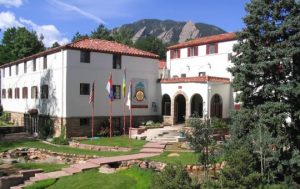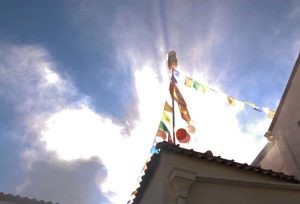Sunday
Community ArticlesShambhala Household Experiment
Reflections on the household culture and Shambhala experience of Boulder’s Marpa House
by Michael Schneeweis
 While many captivating themes run through the Shambhala teachings, the notion of cultivating a wakeful household stands out as a particularly important aspect of the overall vision of our lineage. I feel incredibly fortunate to be a current resident at Marpa House in Boulder, Colorado. Established in 1973 by Trungpa Rinpoche and his students, Marpa house has been a vital—and perhaps overlooked—gem within the Shambhala community for over forty years. Because the primary aim of Shambhala is to create an enlightened society—and because society consists of innumerable households—a core purpose of Shambhala training is to cultivate people’s ability to organize and enact a household environment that is awake, cheerful and visionary. Marpa House is one such place where the living laboratory of Enlightened Society is taking place day after day. Where do our lofty Shambhala ideals meet our present circumstances? If not in our households, where would we cultivate our meditation, lungta, and aspiration for enlightened society?
While many captivating themes run through the Shambhala teachings, the notion of cultivating a wakeful household stands out as a particularly important aspect of the overall vision of our lineage. I feel incredibly fortunate to be a current resident at Marpa House in Boulder, Colorado. Established in 1973 by Trungpa Rinpoche and his students, Marpa house has been a vital—and perhaps overlooked—gem within the Shambhala community for over forty years. Because the primary aim of Shambhala is to create an enlightened society—and because society consists of innumerable households—a core purpose of Shambhala training is to cultivate people’s ability to organize and enact a household environment that is awake, cheerful and visionary. Marpa House is one such place where the living laboratory of Enlightened Society is taking place day after day. Where do our lofty Shambhala ideals meet our present circumstances? If not in our households, where would we cultivate our meditation, lungta, and aspiration for enlightened society?
There are a number of things that make Marpa House a special experiment in household principle. First of all, it is a Buddhist residential community founded with the intention of mixing meditation with everyday life, which is itself a rare and inspiring thing. In addition to this, Marpa House is unique in that it accommodates the lives of thirty individuals – graduate students, full-time employees, retirees, an Acharya – and does so with relative ease and harmony. Anyone who has lived in a communal setting knows that it is no small accomplishment to get dishes done, food cooked, and bathrooms cleaned day after day, week after week. It is a testament to the strength of Marpa House that these tasks get done with regularity and good cheer. How is this awake energy generated, and how does one develop an understanding of how to set up this kind of energy in future households?
In my own observation of life at Marpa House, one of the ways in which I sense the house generates lungta is that it successfully balances privacy with certain forms of “involuntary” connection. Even though sharing a kitchen, dining space, and bathrooms with 30 other people is at times a challenging push towards being accommodating, there is still the privacy of one’s bedroom. And, in case that privacy becomes too alluring and isolating, one’s dish shift and the communal nature of dinner are bound to bring one back to the overall feeling of working and communicating with other people. The dance between getting to do your own thing and being intimately connected to others in practical and regular ways brings about a general sense of shared lungta. That, plus we all meditate, individually and in group practice sessions and monthly house nyinthuns and feasts.
Within our Shambhala lineage, we have many inspiring examples of households that directly nurture qualities of awakenment, gentleness, bravery, and lungta. The most obvious is the Kalapa Court, the home of the Sakyong, the Sakyong Wangmo, and the Jetsunma. The previous Sakyong and Sakyong Wangmo also lived in a Kalapa Court and exemplified the fruition of the Shambhala Household principles. And long ago in Tibet, our lineage ancestor Marpa the Translator lived with his family in an awakened household as well. Another remarkable thing about living at Marpa House is the fact that Lady Könchok (the Sakyong’s mother), her husband Lama Pegyal, and their son Lama Gyurme Dorje live here. A kind and wonderful family, their presence is felt continuously and adds a deep sense of commitment, lineage, and warmth to our community. The family is often heard through the walls of their suite banging drums and symbols, doing pujas and other Buddhist practices. The family cultivates an energy that goes beyond any one person’s existence in the house, and beyond any dramas that may unfold between housemates. There is a sense that Marpa House has a life of it’s own in some regard, and that each individual is a contributing factor, but not the contributing factor, to the overall vision of the household. It is a household energy that, if cultivated and applied fully, could have a palpable impact on its neighborhood and beyond.
The examples of our lineage holders set a very high bar. Of course, enlightened teachers manifest enlightened qualities in every aspect of their lives, whether they live in a mansion, a cave, or in the streets. But for most of us on the path, setting up and living in an enlightened household is not easy at all. For one, we have nobody but ourselves—and if we are so fortunate, our intimate partners—to make sure we are putting our clothes away properly, meditating and contemplating, and washing the windows. Obviously, there is no enlightened attendant checking on us throughout the day to make sure we’re applying the energy required to transform a cocoon into a Court.
Shambhala is not alone in its emphasis on the importance of creating enlightened households. Confucian philosophy also gives much consideration to creating a good society, and the role of the individual household is not overlooked. As Confucius writes in his Analects, “From the loving example of one household, a whole state becomes loving. From the courteous manner of one household, a whole state becomes courteous.” It is a widely shared human insight that there is an important connection between the ways in which small groups of people live and the health of society at large.
The experience of living at Marpa House—the work, the chaos, the fun, the quality of being somewhat forced to extend oneself for the benefit of the whole organism of the community—are shared by many household environments. Whether one is living with a friend, a partner, or a whole extended family, there are opportunities in any home to work with the Shambhala teachings and to try to create harmony and balance. One’s own time and energy, the needs of others, and the overall well-being of the house are all in need of consideration and care no matter where one lives. However, it can be extremely challenging to find this sense of balance, which is why living at a place like Marpa House can be an invaluable reference point for those of us interested in learning not only how to meditate well, but how to live well and be part of a wakeful household.
Like anything worth realizing, the path of the Shambhala household requires dedication and ongoing exploration. Certain things that we foolishly cherish will have to go; other things that we habitually ignore will have to be cultivated. Needless to say, it will be a journey. However, if we are to deliver on our big Shambhala promise to create an enlightened society on this earth, this is a path we must each engage with. I wish us all the best with this process, as do all of our Shambhala ancestors. May enlightened households become the norm! And if you’re ever in Boulder, please come for dinner at Marpa House (and apply to live here).
For more information on Marpa House, visit their website at https://marpa-house.org .
If you’re interested in the possibility of living at Marpa House, you can click here to read about the application process.








Apr 10, 2017
Reply
Thank you for Sharing! great blessings to live at Marpa House!
Apr 9, 2017
Reply
Trungpa Rinpoche used to call Marpa House a landing pad and a launching pad.